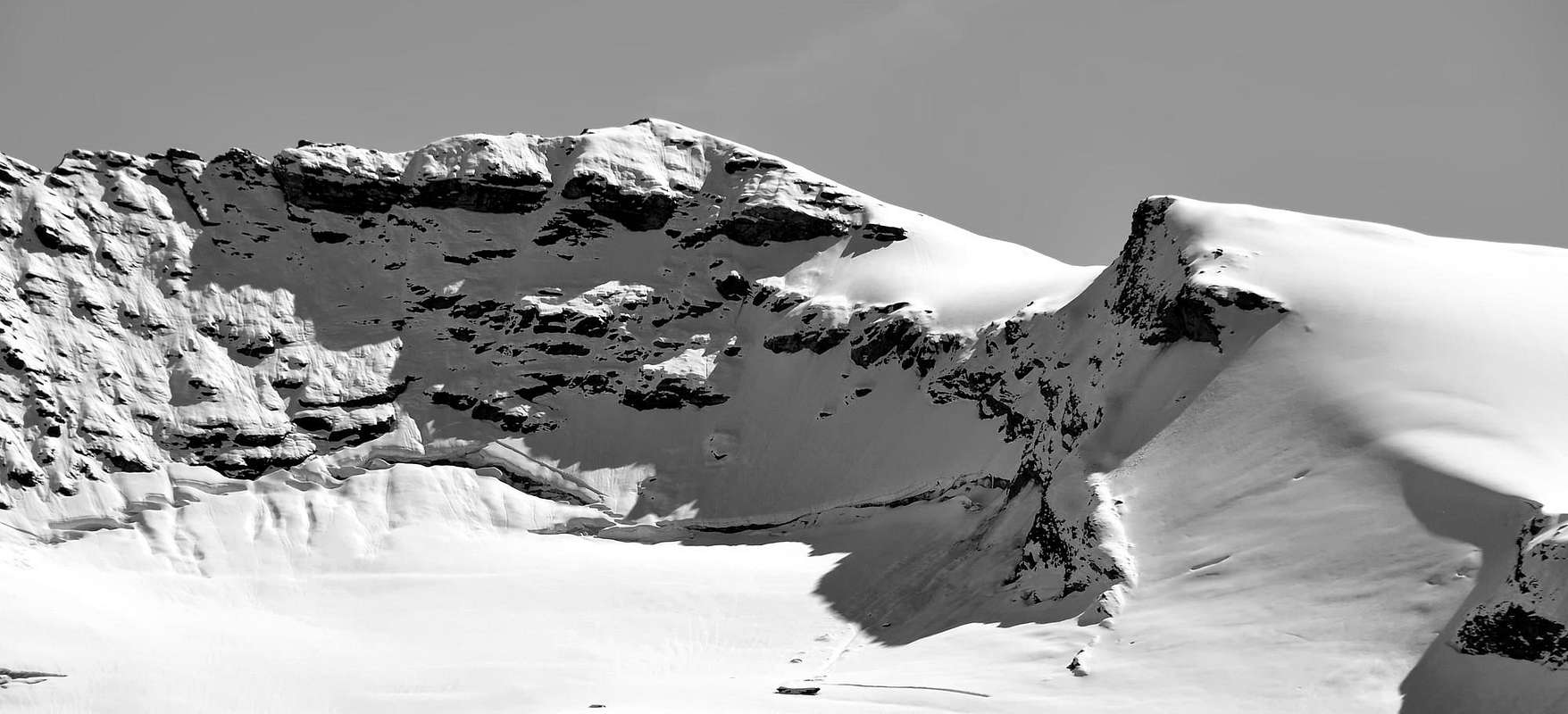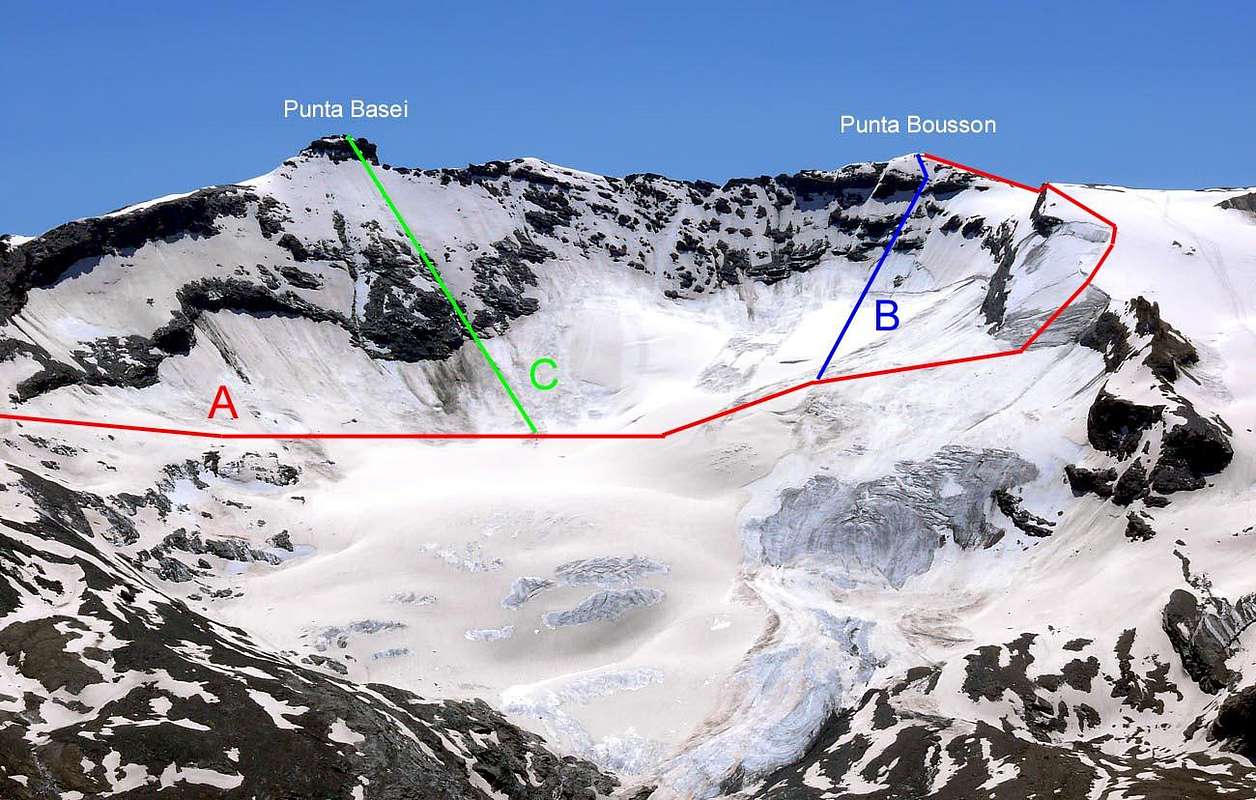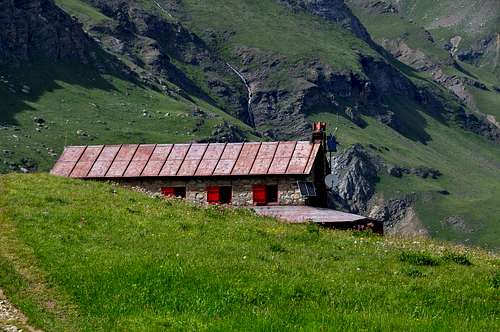-
 7052 Hits
7052 Hits
-
 81.18% Score
81.18% Score
-
 13 Votes
13 Votes
|
|
Mountain/Rock |
|---|---|
|
|
45.47170°N / 7.11245°E |
|
|
10948 ft / 3337 m |
|
|
Overview
Getting There
BY CAR:
- From France: through the Mont Blanc Tunnel or the Col du Petit Saint Bernard: you can drive on SS.26, following directions for Aosta and, before arriving in Villeneuve, turn right towards Introd. Alternatively, you can take Motorway A5 (at Courmayeur or Morgex) and exit at Aosta Ovest.
- From all the other directions: get to the Aosta Ovest exit of Motorway A5. Then drive on SS.26 Aosta, in the direction of Courmayeur; just after Villeneuve turn left towards Introd.
BY PLANE:
- Aeroporto "Corrado Gex" Saint Christophe (Aosta).
Enter the valley and, at the fork between Valsavarenche and Val di Rhêmes turn to the right (Rhêmes). Cross all the villages to arrive to Rhêmes Notre Dame and follow to Thumel (car parking), herefrom, following the dirt road on the right side (ascending) of the valley, or, better with snow, a track on the left that passing throught some fine woods leads you to the Rifugio Benevolo (2.285m)

First Ascents
- First on the Summit: Giovanni Bobba and of Rhêmes mountain' guide Casimire Thérisod, (Aug 16th, 1888).
- W Slope of "Carving" 3.196m and NE Edge): Osvaldo Cardellina, Roberto Cremonese and Domenico Demichelis, (Oct 04th, 1986), in ascent and in day from Thumel.
- NE Ridge (from Basei Point): Giovanni Bobba and of Rhêmes mountain's guide Casimire Thérisod, (Aug 16th, 1888), in ascent.
- SE Eperon: Giovanni Bobba, Luigi Cibrario, Luigi Vaccarone and of Rhêmes mountain guide Casimire Thérisod, (Aug 15th, 1890), in ascent.
- SE Face (Direct Route): Enrico Marta and Giorgio Viale, (Aug 02th, 1970), in ascent.
- SW Crest: Giovanni Bobba and of Rhêmes mountain guide Casimire Thérisod, (Aug 16th, 1888), in descent.
- W-SW Slope (Ski-Mountaineering Route): Unknown or Giovanni Bobba and of Rhêmes mountain guide Casimire Thérisod, (Aug 16th, 1888), in descent.
- N Slope of W Shoulder and W-NW Slope (Standard Route): Unknown also Giovanni Bobba and of Rhêmes mountain guide Casimire Thérisod, (Aug 16th, 1888), in descent.
- N Wall Right Route and N-NW Ridge): Osvaldo Cardellina, Emilio Bertona, Nicola Colajanni and Gianfranco Vicentini, (Aug 22th, 2000), in ascent, in descent and in day.
- N Wall (Direct Route, after descent Basei Point W Face): Osvaldo Cardellina and Giuseppe Lamazzi, (Jul 21th, 1974), in ascent and in day.
- Great Traverse from Lavassey Point, Paletta N and S Points, Grand Vaudala and Little Vaudala Points, Nivoletta N and S Points, Quota 3.163m, Basei Point to Bousson Point: Osvaldo Cardellina and Giuseppe Lamazzi, (Jul 21th, 1974), crossing in day.
Approach to Gian Federico Benevolo Refuge
Approach to Gian Federico Benevolo Refuge: from Parking 1.848m continue in South through the road towards Pasture 1.901m and, leaving left that descending to of Thumel little Village 1.879m; worthy of visit with the tiny bridge nearby a deep gorge) and, by path n° 13, direct one's steps through Great Vaudala(z) Valley (foreground with beautiful waterfall). On the contrary near the pasture start the path n° 13 to Gian Federico Benevolo Refuge (2.285m; abounding signs); crossing below the characteristic small Church 1.936m, go up by South-southwest direction along and from upper the Rhêmes Stream; leaving right the deviation to Fos Alp, cross into a small valley the, with same name, small torrent reaching, by more in Southwest route amongst prairies, the Saint-Pantaleon (2.010m) and Barmaverain (2.037m) Pastures. Very soon wade across the torrent reaching "Cascate Area" (= Waterfalls; 2.051m); by a brief and hardly more steep ascent diagonal, go upper dirt main road and through false level route join at Roman Bridge upon the torrent (2.125/30m~). From this point continue by same road with two narrow hairpin bends to Lavassey Alp (2.227m) also to rejoin by a short cut, at once over the bridge; from pasture by short cut again or by a nearby dirt road reach the refuge, sited on ample grassy-rocky promontory (E; 1h'15/1h'30).
Approachs to various Routes
From Rhêmes Valley seven Routes Description
Route A - (NE Edge from Basei Pass and crossing of Basei Point): from deviation 2.707m in left (Southeast)through Galisia Point Route go up by path n° 13b along the moraine as far as upper crossroads towards Nivoletta (Northeast) and Basei (East) Pass, in quota 3.000m~, reaching, by a more steep terminal part, the last (3.176m; E; 2h'30/3h'00). Briefly go down along the SE Ridge passing two round "humps" with roughness (easy but exposed and more dangerous summital snowy frames extant, generally to East or Valsavarenche Valley) to Saddle/Carving 3.196m; continue false level route in quota by Bousson Point NE Edge doubling in right various pinnacles and narrow carving (the mayor to Rhêmes Slope or West), also crossing in edge (II°+, even III°-; no good rock). By a short final part, snowy often, more steep but more easy to Summit (PD/PD+; 1h'00/2h'00, according to snowy corniches conditions; impossible route sometimes, such as on the end of July 1974, forcing to descent by Basei W Wall for to go on with Bousson Point. 4h'00/4h'30 from refuge).Route E - (N Slope of W Shoulder 3.276m and W-NW Slope or Standard Route through Lavassey and Eastern Fond Glaciers): from the Gian Federico Benevolo Refuge to follow towards South the path n° 13b that conducts to the Nivoletta and Basei Pass, to leave to the left the trace of this last and to go down of few (20/30m~) reaching in the Glacier of Lavassey. To coast along him/it to And under the wall W of the Punta Basei and to reach the terminal crevasses of the Bousson Point W Great Shoulder (Absolutely no cross centre into glacier; collapse snowy bridge great danger on of crevasses web. On October 1986, returning from Summit, in doubt for cut short the route avoiding the more large tour contra the Basei Point, immediately reply: a terrible cannon shot and following great cave at least diameter about 10 meters into centre of glacier!). To go up again I pour him/it and actually to the quota 3.276m, passing approximately half route between the same and three characteristic Yellowy Jags (3.141m), from where for wide and easy crest, also more in right through large icy W-NW Slope, the peak is earned (3h'30/4h'00 from Benevolo Refuge).
Via E - (Versante NW dello Spallone W 3.276 m e Versante W-NW o Via Normale per i Ghiacciai di Lavassey ed Orientale di Fond): dal Rifugio Benevolo (2.285 m) seguire verso S il sentiero n° 13b ad E della Dora di Rhêmes che conduce ai Colli di Nivoletta e Basei; lasciare a sinistra la traccia di questo ultimo e scendere di poco (20/30 metri~) raggiungendo il Ghiacciaio di Lavassey. Costeggiarlo ad E sotto la Parete W della Punta Basei (crepacci!) e raggiungere la crepaccia terminale del Grande Spallone W della Punta Bousson (Assolutamente non attraversarlo; grande pericolo di crollo nella ragnatela di crepacci, soprattutto nel centro del ghiacciaio. Nell'Ottobre del 1986, in discesa nel dubbio di rifare il giro un pò più lungo sotto la Basei, abbiamo avuto una immediata risposta: una grande cannonata ed una voragine di almeno 10 metri di diametro improvvisamente apertasi proprio nel mezzo dello stesso!). Risalirlo (35°/40°) verso E (spesso verglass) sino alla quota 3.276 m, transitando a circa metà strada tra la stessa ed il caratteristico e triplice Dente Giallognolo (3.141 m), donde per larga e facile cresta, oppure più a destra sull'aperto pendio glaciale W-NW, si guadagna la vetta (3h'30/4h'00 dal Rifugio Benevolo).
Route F - (SW Crest from Saddle/Shoulder 3.300m~ or Bousson Pass also from Galisia Point): reached the large Saddle/Shoulder 3.300m~, also Bousson Pass with name, by Route E and between the Galisia and Bousson Points, turn left (Northeast) easily gaingin, by a brief SW Ridge, the Summit. Equally crossing from Galisia Point (3.346m), after ascent through any route (EE/A; F; 0h'15).
Via F - (Cresta SW dalla Sella/Spalla 3.300 m~ o Colle Bousson oppure dalla Punta Galisia): raggiunta la larga Sella/Spallone 3.300 m~, o Colle Bousson, tra la Punta Galisia e la Punta Bousson con l'itinerario E, svoltare a sinistra (N-NE) e pervenire facilmente, tramite la breve Cresta SW, alla Vetta, senza incontrare particolari difficoltà. Ugualmente provenendo dalla Punta Galisia (3.346 m), raggiunta per qualsivoglia via (EE/A; F; 0h'15).
Route G - (W-NW Slope also Ski-Mountaineering Route through the Eastern Fond Glacier): from deviation 2.707m and by approach B go up to of Fond Glacier base; in East completely climb, preferably contra Point Bousson W-NW Crest (be careful: from Great Shoulder 2.707m , more in South, blocks falls also snowslides possibility; see the pictures). Completely going the W-NW Slope, no disregard crevasses in existence and reach the Bousson Pass and following SW Crest (EE/A; 1h'30/2h'00; by ski-mountaineering necessary conditions of snow completely transformed; in total from Gian Federico Benevolo Refuge 4h'00/4h'30).
Via G - (Versante W-NW o Via Sci-Alpinistica per il Glacier de Fond Orientale): dalla deviazione 2.707 m e con l'avvicinamento B portarsi alla base del Glacier de Fond; risalirlo completamente verso E, tenendosi principalmente contro la Cresta W-NW della Punta Bousson (attenzione a non transitare troppo a S, poiché dallo Spallone 3.276 m esiste la possibilità di caduta di blocchi di roccia o slavine; guardare le fotografie). Risalire totalmente il Versante W-NW, non trascurando la presenza di crepe, e raggiungere il Col Bousson e la seguente Cresta SW (EE/A; 1h'30/2h'00; in sci-alpinismo richieste condizioni di neve completamente trasformata; complessivamente dal rifugio 4h'00/4h'30).
DESCENTS: exclusively advised the Route E, by descent from Great Shoulder 3.276m and a more large tour on Lavassey Glacier before in East-northeast, after North contra Basei Point W Face, with of Route E same remarks and considerations. Alone by ski-mountaineering the Route G.
DISCESE: è consigliata esclusivamente la Via E, con discesa dallo Spallone 3.276 m e susseguente giro più largo sul Ghiacciaio di Lavassey prima verso E-NE, poi a N contro la Parete W di Punta Basei, con le stesse osservazioni e considerazioni di Route E. Solo per lo sci-alpinismo la Via G.
Difficulties
This route can be considered F/PD+.Essential Gear
Mountaineering equipment, including rope, iceaxe, and crampons.Huts
Rifugio GIAN FEDERICO BENEVOLORed Tape
The Eastern side of the valley belongs to Gran Paradiso National park, the Western one is out of the boundaries of the Park ... but nature must be respected.Campings
Remember that free camping is forbidden (except for emergency reasons, over 2.500m, from darkness until dawn).Mountain Conditions
- You can get meteo information at the official site of the Regione Valle d'Aosta:
- Valle d'Aosta Meteo
- Meteo: You can find more weather information on the website 3B Meteo:
- Meteo Rhemes Notre Dame
Webcam
- WEBCAM on Aosta Valley:
- Webcam
Books and Maps
BOOKS:- "Guida delle Alpi Occidentali" di Giovanni Bobba e Luigi Vaccarone C.A.I. Sezione di Torino Volume II (parte II), 25 Maggio 1896.
- "Guida dei Monti d'Italia-Gran Paradiso Parco Nazionale" E. Andreis, R. Chabod, M. C. Santis, Club Alpino Italiano/Touring Club Italiano, prima Ed. 1939; seconda Ed. 1963; terza Ed.
- "Guida della Regione Autonoma Valle d'Aosta" di Mario Aldrovandi,Ed. S.P.E. di Carlo Fanton, Torino 31 Dicembre 1964.
- "Rifugi e bivacchi in Valle d'Aosta", di Cosimo Zappelli aggiornata da Pietro Giglio, Musumeci Editore, Luglio 2002.
- "Diari Alpinistici" di Osvaldo Cardellina e Indice Generale accompagnato da Schedario Relazioni Ascensioni 1964-2019 (inediti).
MAPS:
- Kompass "Gran Paradiso Valle d'Aosta Sentieri e Rifugi" Carta Turistica 1:50.000.
- Enrico Editore Ivrea-Aosta "Gruppo del Gran Paradiso" 1:50.000.
- I.G.C. Istituto Geografico Centrale Torino "Valsavarenche Val di Rhemes Valgrisenche Parco Nazionale del Gran Paradiso", (carta n° 102), 1:25.000.
- I.G.C. Istituto Geografico Centrale Carta dei sentieri e dei rifugi "Il Parco Nazionale del Gran Paradiso" 1:5.0000.
Important Information
- REGIONE AUTONOMA VALLE D'AOSTA the official site.
- FONDAZIONE MONTAGNA SICURA Villa Cameron, località Villard de la Palud n° 1 Courmayeur (AO) Tel: 39 0165 897602 - Fax: 39 0165 897647.
- SOCIETA' GUIDE ALPINE DEL GRAN PARADISO Comune di Valsavarenche.
- A.I.NE.VA. (Associazione Interregionale Neve e Valanghe).
Useful numbers
- Protezione Civile Valdostana località Aeroporto n° 7/A Saint Christophe (Ao) Tel. 0165-238222.
- Bollettino Meteo (weather info) Tel. 0165-44113.
- Unità Operativa di Soccorso Sanitario Tel. 118.
Acknowledgements
I am greatly indebted to my friend "Osva" for the detailed description of all the texts and for the translation into English.

















